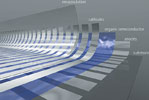
Southern Africa
With the EU approval from end of June 2005 having removed the last barrier to conclude the acquisition of the Memec Group by Avnet, Avnet Electronics Marketing EMEA has officially announced its post-acquisition strategy.
Marthinusen & Coutts, a former division of Delta Electrical Industries, has announced that its recent change in ownership brings with it a strong black-empowered equity component. According to Gavin Garland, managing director of Marthinusen & Coutts, black-owned companies AKA Capital and Sphere Holdings hold 26% equity in the new consortium, which recently acquired Delta Electrical Industries' repairs and services division.
Tactile Technologies has opened a Gauteng branch office located at The Innovation Hub in Pretoria, and appointed Ernst Ohlhoff to head up the new branch. See 'Tactile Technologies moves into Gauteng'.
Overseas
Business
NEC Electronics has lowered its guidance for sales revenue in the first fiscal quarter ended 30 June, and more than halved its full-year profit forecast. The company blamed slowing sales of semiconductors used in mobile phones and microcontrollers for embedded applications and said the market would hit the bottom of its current cycle in July 2005. It said it could then take up to six months to resume strong growth. NEC expects its first quarter net sales to be approximately 13% smaller than in the previous quarter.
Integrated Device Technology (IDT) has reduced its revenue outlook for the first quarter. Based on recent shipment trends to customers, IDT said it now projects revenue to be down approximately 3 to 4% from the immediate preceding quarter's revenue of $97,1m. Previously, the communications chipmaker estimated revenues for the quarter to be flat to up 4% relative to the prior quarter. IDT has just announced plans to acquire Integrated Circuit Systems for $1,7 bn.
Microprocessor supplier, AMD, has posted stronger than expected results with sales of $1,26 bn and net income of $11m, for the second quarter ended 26 June. For the same quarter last year, AMD reported sales of $1,262 bn and net income of $32m.
Companies
Motorola is acquiring key assets from Sendo, a UK mobile handset manufacturer. The acquisition includes Sendo's entire IP portfolio, including 50 existing and 40 pending patents, as well as Sendo's UK and Singapore-based R&D team and design and test equipment.
Tektronix has acquired TDA Systems, a provider of interconnect analysis software tools.
Magnum Semiconductor has completed its acquisition of Cirrus Logic's digital video product line assets. Cirrus Logic said it wants to focus on its core analog, mixed-signal and embedded IC product lines for audio and industrial markets.
AU Optronics, the Taiwan-based LCD supplier, has signed an agreement with IBM to acquire its hundreds of global patents related to thin-film-transistor (TFT) LCD technology. It has also entered into a patent cross-licence agreement to license relevant products under other patents owned by both companies. The patents cover TFT array processes, cell processes, RGB colour filters, backlights, driving circuits, and other technologies.
Premier Farnell has concluded a global distribution agreement to market Sipex products. Sipex manufactures a broad range of analog signal processing products. Premier Farnell's Europe and Asia Pacific business, Farnell InOne, will work with its US sister company, Newark InOne, to deliver the range to customers across the Europe, Asia Pacific and USA regions.
STMicroelectronics has announced a cooperative marketing initiative with Cooper Bussmann through its electronics business unit, Cooper Electronic Technologies, to focus on the global telecoms market. The two will cooperate in promoting complementary telecom products, and in the definition of new products, to provide a complete protection solution set for telecom customers.
Milton Keynes, UK-based Matsushita Electric Works, with its brand name NaiS, has been renamed Panasonic Electric Works UK (PEWUK) and has adopted Panasonic as its new brand name. The company was originally incorporated into the Matsushita Electric Works group in 1989, now itself a part of the Panasonic global organisation.
IMEC, the Leuven, Belgium-based research centre for design, semiconductor devices and processes, nanoelectronics and nanotechnology, has agreed to work with Semizone ( www.semizone.com/imec) to create and offer on-line courses to address the needs of ASIC and SOC designers, process technicians and junior process engineers.
Swiss startup, Locatis, is using Sarantel's GeoHelix GPS antenna in a GPS-based pet-tracking device. The PB100 is a lightweight, water-resistant GPS/GSM device, which has been developed for the tracking of dogs. The device is attached to a dog's collar, and responds to an SMS text message. The location is then sent as an address in a returned SMS text message.
Industry
The market for macro cellular base stations is set to increase from 1,8 million units in 2004 to 3,5 million units in 2009, according to market research company In-Stat. The company adds that the number of worldwide cellular subscribers will hit 2,6 billion in 2009, up from 1,6 billion in 2004. This is equivalent to about a 14% compound growth rate.
Intel and actor, Morgan Freeman, have launched ClickStar, a digital entertainment company focused on distributing movies directly to consumers over the Internet. ClickStar's strategy is to create an online service where consumers can download for a fee, first-run pre-DVD-release films and artist-created entertainment channels.
In-Stat has reported that the worldwide retail value of all digital terrestrial TV (DTT) set top boxes (STBs) will 'blast off' during 2006, and drive up to more than $10 bn during 2009. Surprisingly, Australia currently leads the world for consumption of high definition TV DTT set top boxes, with North America running in second place, it says.
General Atomics has announced that its spectral keying ultrawideband (UWB) radio technology has been certified by the FCC. This approval means that its customers will be able to integrate its UWB chip set into wireless radio systems. Spectral keying UWB allows the combining of impulse radio architectures with multiple, independent frequency bands. According to the company, this capability enables radios to operate without interference in high multipath environments.
QinetiQ is researching the potential for printing complete electronic circuits, including transistors, resistors and capacitors, with separate backing from the UK's DTI and MOD. In the consumer sector, it says, the technology being investigated could help reduce the cost of many electronic products, while in the defence field, it could enable electronic functionality to be added to structural components of systems or to clothing. The research is based on using thin polymers, not silicon, as a semiconductor, adding the benefits of flexibility and improved robustness to the resulting circuits.
OFMC 2005, Europe's leading conference for measurement for optical fibres and optoelectronics, is scheduled to be held at the National Physical Laboratory in the UK, from 21 to 23 September 2005.
Technology
A new technique for fabricating liquid cooling channels onto the backs of high-performance IC could allow denser packaging of chips while providing better temperature control and improved reliability. Developed at the Georgia Institute of Technology, the wafer-level fabrication technique includes polymer pipes that will allow electronic and cooling interconnections to be made simultaneously using automated manufacturing processes. According to the researchers, the low-temperature technique, which is compatible with conventional microelectronics manufacturing processing, allows fabrication of the microfluidic cooling channels without damage to ICs.
Sandia National Laboratories in cooperation with Time Domain and KoolSpan has developed an ultra-secure wireless data communication network that combines ultrawideband (UWB) radio signals with advanced encryption techniques to develop a secure sensor and communications network for the US military. With UWB spreading of impulse energy over a wide frequency spectrum, the signal power falls near the noise floor of radio circuits, making these signals extremely difficult to detect, intercept or jam. When this is combined with AES, it is virtually impossible to crack, says the group.
Scientists from the Kavli Institute of Nanoscience at Delft, The Netherlands and Philips Research in Eindhoven, have developed superconducting transistors based on semiconducting nanometer-scale indium arsenide wires. The devices enable the fabrication of novel nanoscale superconducting electronic circuits and at the same time provide opportunities for the study of fundamental quantum transport phenomena, said Philips. In the Kavli-Philips devices, a supercurrent can flow through the nanowire from one superconducting contact to the other. This supercurrent can also be controlled by a gate voltage, making it a supercurrent transistor.
RF Engines has released a library of more than 60 Fast Fourier Transform (FFT) cores for use in Xilinx FPGA devices. Supplied on a single CD, it includes FPGA netlists for a range of FFTs that cover different target devices, transform lengths and sample rates.
Universal Display Corp has developed a durable blue phosphorescent organic LED (PHOLED) that it claims has surpassed the 1000-hour lifetime barrier by a wide margin. The new version can last up to 15 000 hours, at 200 cd/m², and also offers excellent efficiency, a trait for which the Company's PHOLED technology is renowned, with 9,5% external quantum efficiency and 22 cd/A luminous efficiency. With CIE coordinates of (0.16, 0.37) and a 474 nm peak emission wavelength (sky blue colour), the company says it is not yet saturated enough for commercial full-colour applications, although it can be used in lighting. The company is now working on its 'deep blue' PHOLED to meet commercial OLED needs.
RoboCup 2005 was held in Osaka from 13-19 July under the theme; 'By the year 2050, develop a team of fully autonomous humanoid robots that can win against the human world soccer champion team.' Almost 400 teams of humanoid robots from over 30 countries participated. Robotrex, an exhibition of robot technologies and products, was held at the same venue. See www.robocup.org.

NanoIdent Technologies of Austria has developed a photonic sensor it claims is the world's first high-resolution, organic semiconductor-based photonic sensor for high-volume industrial applications. The 256-pixel sensor, with 250 dpi resolution, represents a new class of sensors. Potential applications include flexible fingerprint sensors for smartcards and large biochip sensors. The NanoIdent sensors consist of flexible PET foil with ultra-thin layers of micro-structured electrodes and photoactive semiconductors. Organic semiconductors can be cost-effectively processed in liquid form like printing ink.

Scalar Corporation has integrated Kopin's CyberDisplay 180K colour-filter microdisplay into its Teleglass, claimed to be the world's smallest video eyewear for video-on-the-go applications. Connected to a mobile phone, portable DVD player or digital camera, Teleglass projects high-resolution video onto eyeglasses, creating a virtual 71 cm TV screen as viewed from 213 cm. The eyewear projects images in one eye, enabling the wearer to privately watch movies or TV, read text or view pictures without obstructing the other eye. The colour-filter active matrix liquid crystal display (AMLCD) has a resolution of 800 by 225 (180 000) colour dots.

Fujitsu Laboratories has developed a new fuel-cell material technology that it says enables the use of 30% methanol (highly concentrated) as the fuel source. This technology enables much higher power capacities for passive micro fuel cells and realises longer runtimes for mobile devices such as laptops and PDAs. Fujitsu developed a new technology for the membrane electrode assembly (MEA): an aromatic hydrocarbon solid electrolyte material, which allows slow methanol permeation, is covered with a high density of highly active platinum-based nano-particle catalyst with methanol-blocking properties. This reduces the methanol crossover effect to a tenth that encountered with typical fluorinated polymers, allowing direct use of a methanol concentration, previously too high to use. This gives greater capacity. The prototype cell is 15 mm thick, and can deliver power levels of 15 W.

A revolutionary new laser under development at the DOE's Lawrence Livermore National Laboratory could drastically reduce casualties by US forces. The Solid State Heat Capacity Laser program has already successfully achieved world-record energy output. It is hoped the system will eventually allow infantry units to use a beam of invisible light to destroy incoming mortars, artillery shells and anti-tank missiles, as well as defusing buried landmines. The US Army's Space and Missile Defense Command is sponsoring the program, which uses a unique pulsed beam that fires 200 times per second, and can already easily burn a hole through 25 mm carbon steel in approximately seven seconds.

© Technews Publishing (Pty) Ltd | All Rights Reserved